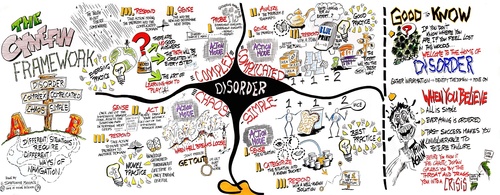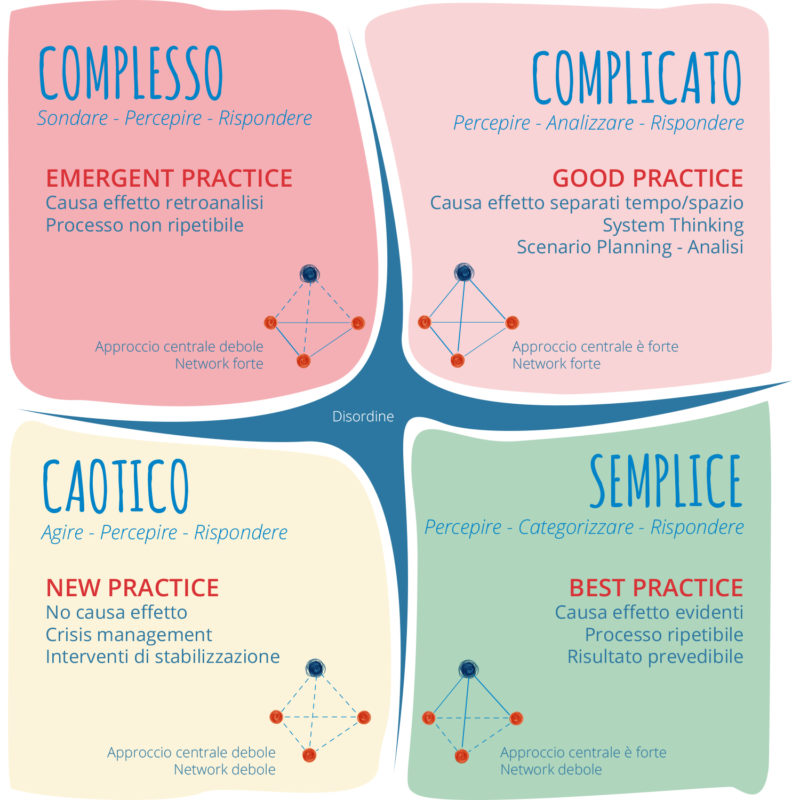Cynefin, pronounced ‘canevian’, is a Welsh word and its authorship is attributed to Dave Snowden.
The meaning of the word cynefin is ‘place of multiple belongings’ the place of our multiple belongings.
Cynefin: different decision models based on context
The assumption of exploration in the Cynefin framework is that the decision-making models and the associated thinking patterns change according to the context of which our activities belong.
The visualization below is the work of an inspired hand belonging to my friend Edwin Stoop (sketchingmaniacs.com).

Cynefin is a sense making model and not a categorization model typical of consulting matrices. These 2×2 matrices are usually suitable for the evaluation of data after their emergence, they analyze the Past, i.e. they are used for ex-post understanding. In a sense making model the framework emerges from observations, from data, in a social context and serves for exploration, the focus is on the Future.
Orderly contexts
1. SIMPLE
Decision-making model > Perceive-Categorize-Response
The BEST PRACTICEs are legitimate in this domain because the cause and effect relationships are linear and clear to all. In addition, best approaches are easily identified and proposed.
2. COMPLICATED
Decision-making model > Perceive-Analyze-Response
The cause and effect relationships here are also linear, but not obvious, so analysis or intervention by an expert is required. In this context, there are many practices that are equally suited to the activity if substantiated by the corresponding expertise, they are GOOD PRACTICEs, and forcing some of them can be counterproductive, especially when they are seen as best practice, even though they are not.
In this case, those who have to work with them will often end up not contributing to the evolution of these practices because they are wrongly presented as being “best”, despite the fact that the experience of those who work with them says otherwise.
Non-orderly contexts
1. COMPLEX
Decision-making model > Experiment-Perceive-Response
These complex contexts are causality-free, with low constraints on those who act in them, where agents continually modify the system which in turn is interdependent on agents.
The results of experiments cannot be known in advance, so one must design differently than in orderly contexts where process rationalizations (BPR, 6Sigma,..) are desirable.
This approach to design can be called safe-fail and differs from design in orderly systems which is called fail-safe. In complex systems, failures must be allowed and designed in such a way that they provide important insights into the scope in order to inform those who must pursue new experimentation in this area.
Safe-Fail design means experimenting, and, if there is evidence of success, amplifying; otherwise, in the event of failure, abandoning while recording what was learned. Amplification or abandonment strategies must consequently be very clear before experimentation begins.
This kind of planning leads to an emergent order (EMERGENT PRACTICES), thus different ways of doing things.
2. CHAOTIC
Decision-making model > Act-Perceive-Response
You may end up there unintentionally, or if you are looking for disruptive innovations – NEW PRACTICES – you may purposely create a “chaos space”. In these contexts you don’t experiment, you must act now because the state of chaos can be very dangerous. Important insights into how chaotic systems work come from disaster anthropology.

